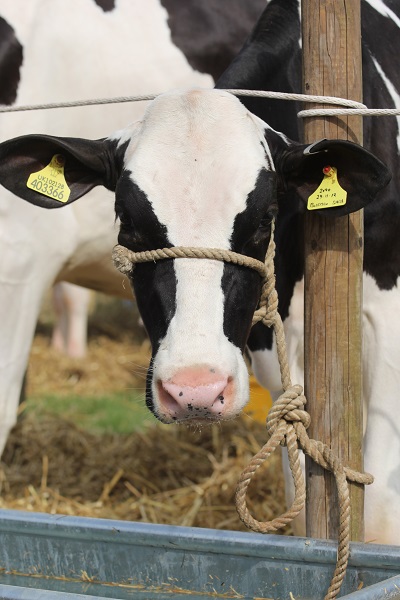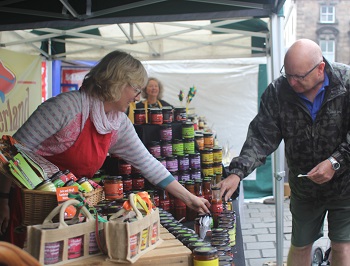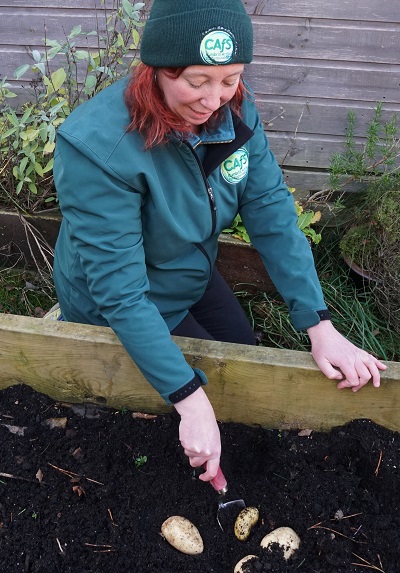Your food serves up one of the biggest portions of your carbon footprint.
Globally, greenhouse gas emissions from food amount to roughly 30 percent of humanity’s carbon output, according to a 2020 report – a huge proportion. What you eat, where it comes from, how it reaches you and how it’s packaged all contribute. Just a few changes can make a big difference. Try some of our tips and suggestions to reduce your food carbon footprint.
Also visit our section on reducing food waste.
The Future of Food – a Zero Carbon Cumbria webinar
This workshop explored some of these key challenges and solutions in food production, supply and consumption, and consider how an innovative and collaborative approach across the Zero Carbon Cumbria Partnership and beyond can best ensure we meet these food needs of the future.
Our top tips
- Eat less meat & dairy
- Eat seasonally
- Buy food produced near you
- Grow your own food
1. Think about meat & dairy products
 You’ve probably seen the media articles about cutting down on meat and dairy products to reduce your food carbon footprint. (Here’s a recent one from The Guardian.) It’s a view that’s often shared in green living guides, because of the greenhouse gas emissions generated by cows in particular.
You’ve probably seen the media articles about cutting down on meat and dairy products to reduce your food carbon footprint. (Here’s a recent one from The Guardian.) It’s a view that’s often shared in green living guides, because of the greenhouse gas emissions generated by cows in particular.
Ruminating animals like cows and sheep belch methane, which is much more potent than CO2 when it comes to trapping heat in our atmosphere. Where vast swathes of forest have been destroyed to provide grazing land for cattle, the climate impact of eating beef is even higher. There are now around a billion cows on the planet, and demand for meat and dairy products is expected to rise globally.
It’s one of the reasons for recent campaigns to encourage people to eat less meat, and for the rise in popularity of vegan and vegetarian diets. The rapid increase in meat-free alternatives in supermarkets and restaurants has been astounding, as are the improvements in taste and texture! Check out veganuary.com or bosh.tv for some great vegan recipes.
On the other hand, grazing animals on existing pasture land can play a vital role in keeping soil healthy, if they are managed in the right way. Healthy soils capture and store carbon. It’s been widely reported that the world’s soils are becoming so depleted that they only have another sixty years of harvests left in them. If we’re going to address this devastating trend, then there must be changes globally in the way that land and animals are managed. (For a good overview on this, watch The Magic of Soil – an illustrated talk by Professor Phil Gregory.)
Agriculture isn’t our area of expertise at CAfS, but, purely from a climate change point of view, we feel the key is scale and balance. We feel the current scale of meat and dairy production and mass farming methods aren’t sustainable, but we are open to the evidence mentioned above that animals can be part of a healthy system if managed in the right way.
We’d encourage you to find out more about the issues and form your own view.
 2. Shop locally & seasonally
2. Shop locally & seasonally
Food produced near you AND in season will generally have a lower carbon footprint than imported produce. That’s mainly because there’s less CO2 generated in transporting it to you.
As always, there might be exceptions. Fruit and veg that need artificial heating and lighting to grow in our climate might have a lower carbon footprint when they’re grown naturally in a warmer country and transported here. In general, though, local tends to be best where climate change is concerned.
Here are a few ideas for finding locally grown food:
- farmers’ markets
- farm shops
- veg bag schemes
- shops selling locally grown and produced goods
- food festivals
3. Grow your own
 We’re not going to pretend that growing your own food is quick and easy. When it comes to reducing food miles, though, you can’t get much better than a few steps from your own back door! Even if you don’t have a garden, perhaps the allotments and shared growing spaces around Cumbria might be an option for you.
We’re not going to pretend that growing your own food is quick and easy. When it comes to reducing food miles, though, you can’t get much better than a few steps from your own back door! Even if you don’t have a garden, perhaps the allotments and shared growing spaces around Cumbria might be an option for you.
There are lots of excellent resources online to help you grow your own food. You’ll find guides and how-to videos on preparing your soil, pest control and growing specific fruit and vegetables.
The Royal Horticultural Society website is a good all-rounder.
You can’t beat learning from other local growers, though. Look out for community gardening groups in your area, shared polytunnels, allotment societies and courses and events by organisations around Cumbria.
You’ll find a few links below.
CAfS factsheet
Help people in your area get started with growing their own fruit and vegetables:
The Future of Food – A Zero Carbon Cumbria webinar
This workshop explored some of these key challenges and solutions in food production, supply and consumption, and consider how an innovative and collaborative approach across the Zero Carbon Cumbria Partnership and beyond can best ensure we meet these food needs of the future.
Events & courses
Here are just a few of the groups in Cumbria that sometimes run event and courses on growing food. Look online for others in your district.
Allotments
District councils tend to look after allotments, although some are managed by other organisations including town councils. Check out the arrangements in your area below. If you know of other allotment links we should include here, please let us know!
Orchard groups
If you’re interested in growing fruit like apples, pears and damsons, the members of Cumbria’s orchard groups have a wealth of experience to share.
This online tool that shows you the impact your food has on the global environment in terms of greenhouse gas emissions. Enter the foods you eat, and it will also show you the nutritional qualities and deficits. You’ll get suggestions for changes you could make, so that your diet is healthier for you and the environment.
Our World in Data has produced a graphic using data from the largest analysis of global food systems to date by Poore and Nemecek in 2018.
It shows the greenhouse gas emissions from different food types. For each, it gives a breakdown of the emission for each step in the production (i.e. land use change, farm, animal feed, processing, transport, retail, packaging).
The study highlights that the most significant factor by far is the food type itself, although transport and packaging contribute to the carbon footprint. Animal-based foods have a far higher impact than plant-based foods.
This BBC article and online tool is based upon the same data set and allows you to explore the carbon impact of different food choices.
Dietary choices have an impact on health, greenhouse gas emissions and land use. Find out more in this report by the Centre for Alternative Technology, People, Plate & Planet.
Sustainable certification
There are various standards you can find on food packets that indicate whether the food has been sourced and produced sustainably. Logos to look out for next time you’re shopping include Fairtrade (protecting farmers and workers in developing countries and their ability to produce sustainable food), Organic, Freedom Food (animal welfare), MSC and ASC (wild and farmed seafood respectively), and RSPO (palm oil).
There are also certification standards that cafes and restaurants can achieve, including the Food Made Good standard from the Sustainable Restaurant Association and the Food for Life Served Here standard from the Soil Association. Perhaps look out for these when you’re next planning a meal out…
